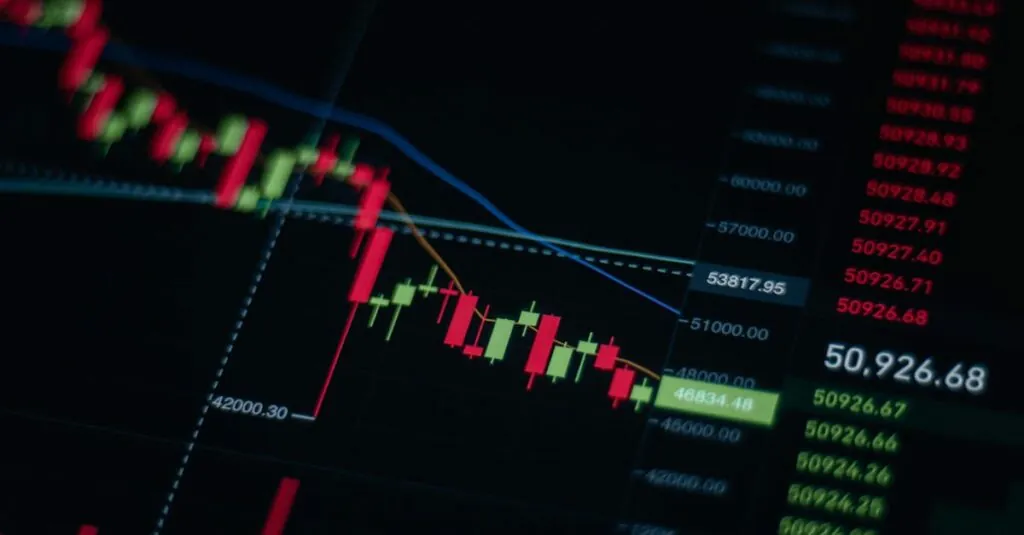In a world where coffee prices can skyrocket faster than a rocket to Mars, understanding currency fluctuation trends is more crucial than ever. Imagine trying to buy that perfect espresso only to find out your dollars have suddenly turned into Monopoly money. Currency values dance to their own tune, influenced by everything from geopolitical events to economic indicators, and keeping up can feel like trying to catch a greased pig.
But fear not! Navigating these financial waters doesn’t have to be a circus act. By grasping the trends behind currency fluctuations, individuals and businesses can make smarter decisions and avoid the pitfalls of unexpected costs. So grab your favorite beverage and settle in as we unravel the mysteries of currency trends, ensuring you’re always a step ahead in this fast-paced economy.
Table of Contents
ToggleOverview of Currency Fluctuation Trends
Currency fluctuations reflect the instability in exchange rates, which can impact international trade. Geopolitical events play a significant role in driving currency value changes. Economic indicators such as inflation rates and employment statistics also influence these fluctuations. Central banks use monetary policy to stabilize or destabilize currency values to meet their economic objectives.
Market sentiment and speculation contribute to short-term fluctuations. Investors monitor trends closely, adjusting positions based on perceived risks. A strong economic outlook often leads to currency appreciation, while weak performance can result in depreciation.
Recent data highlights notable trends in major currencies. The U.S. dollar tends to strengthen during global uncertainties, while emerging market currencies may weaken under similar conditions. Historical events illustrate how sudden geopolitical tensions or economic crises generate significant movement in currency values.
Understanding these trends offers individuals and businesses valuable insights. Awareness of currency fluctuation trends plays a critical role in financial planning and risk management. While changes can seem random, they often reflect underlying economic conditions and global events. By staying informed, stakeholders can navigate the complexities of the currency market effectively.
Factors Influencing Currency Fluctuation Trends
Currency fluctuations result from multiple factors affecting global exchange rates. Economic indicators and political stability play significant roles in these trends.
Economic Indicators
Economic indicators impact currency values significantly. Inflation rates affect purchasing power, while employment statistics signal economic health. A strong job market often leads to currency appreciation, as it reflects consumer confidence and growth. Conversely, high inflation can trigger depreciation of that currency due to decreased demand. Central banks monitor these indicators closely and might adjust interest rates to stabilize the economy. Recent data illustrates that currencies of nations with robust economic data tend to strengthen against weaker economies.
Political Stability
Political stability directly influences currency confidence. Countries experiencing political turmoil or uncertainty tend to see their currencies weaken. Investors often avoid risk, leading them to move capital toward stable governments. Consistent leadership and transparent policies foster investor trust, supporting currency strength. Unexpected elections or geopolitical tensions create fluctuations in currency markets as investors react to perceived risks. For instance, nations with strong political environments typically enjoy favorable exchange rates compared to those facing instability. The interplay between governance and currency value remains crucial in understanding market dynamics.
Historical Currency Fluctuation Trends
Currency fluctuation trends reveal how historic events shape exchange rates. Analyzing past occurrences helps stakeholders understand potential future movements.
Case Studies
The 2008 financial crisis serves as a primary example. It resulted in major currencies like the Euro and British Pound experiencing significant depreciation. The U.S. dollar, conversely, strengthened during this period. Another case, the Brexit referendum in 2016, led to the British Pound plummeting to a 31-year low against the dollar. These case studies illustrate that unexpected political and economic changes can drastically alter currency values within a short timeframe.
Notable Events
Several notable events highlight the impact of geopolitical tensions on currency stability. The Gulf War in the early 1990s prompted an immediate drop in the value of the Iraqi Dinar. Moreover, the COVID-19 pandemic caused worldwide economic disruptions in 2020, leading to further fluctuations in currencies globally. The U.S. dollar demonstrated resilience amid uncertainty, while emerging market currencies faced intense pressure. Each instance emphasizes the connection between external events and currency values.
Impact of Currency Fluctuation Trends on Businesses
Currency fluctuation trends directly influence business operations, especially for companies engaged in international trade. Fluctuating exchange rates often affect pricing strategies; businesses may need to adjust prices based on currency strength. Such adjustments can alter profit margins, resulting in either increased costs or decreased revenues.
Earnings can also vary significantly due to currency changes. Companies earning revenues in foreign currencies might see profits diminish when those currencies weaken against the U.S. dollar. Conversely, firms importing goods may benefit when the dollar appreciates, allowing for cheaper procurement costs. Maintaining competitive pricing requires businesses to monitor exchange rate movements closely.
Supply chain dynamics are another area impacted by currency fluctuations. An unstable currency environment complicates long-term contracts, as pricing terms may no longer be favorable. Businesses also face challenges in budgeting and forecasting, as exchange rate predictions often come with high uncertainty.
Operational decisions often hinge on currency trends. Companies may explore shifting production to countries with favorable exchange rates. Such moves reduce costs but introduce new logistical challenges. Additionally, firms with extensive international operations often consider hedging strategies. Hedging can mitigate risks associated with currency volatility, protecting against unforeseen financial impacts.
Market sentiment can drive short-term fluctuations that affect business decisions. Investors and business leaders might adjust strategies based on anticipated economic changes. Understanding the interplay between economic indicators and currency values becomes vital for making informed decisions.
Sector-specific characteristics can amplify currency impacts. Export-oriented sectors typically face heightened consequences from currency fluctuations. On the other hand, industries less reliant on international markets may experience minimal effects. By comprehensively analyzing these trends, businesses can develop effective strategies to navigate the complexities of currency fluctuations.
Currency fluctuation trends are crucial for anyone involved in international trade or investment. By understanding the factors that drive these changes, individuals and businesses can make strategic decisions to protect their interests. Staying informed about economic indicators and geopolitical events can provide a competitive edge in navigating the complexities of the currency market.
As trends evolve, adapting strategies in response to currency movements becomes essential for maintaining profitability. With the right knowledge and tools, stakeholders can better manage risks and seize opportunities presented by currency fluctuations.




